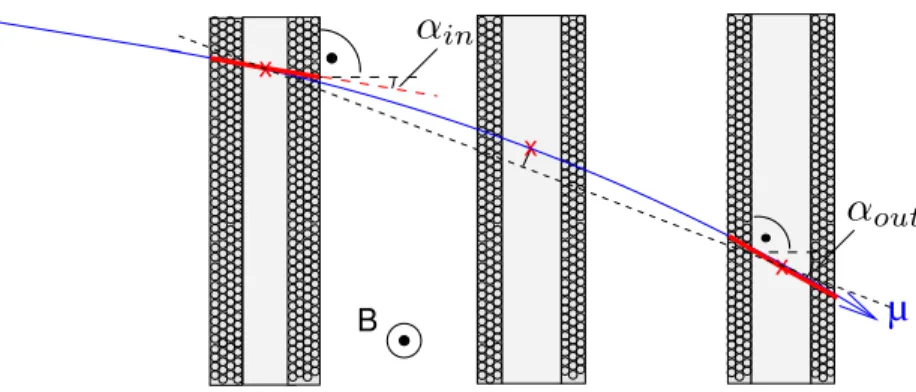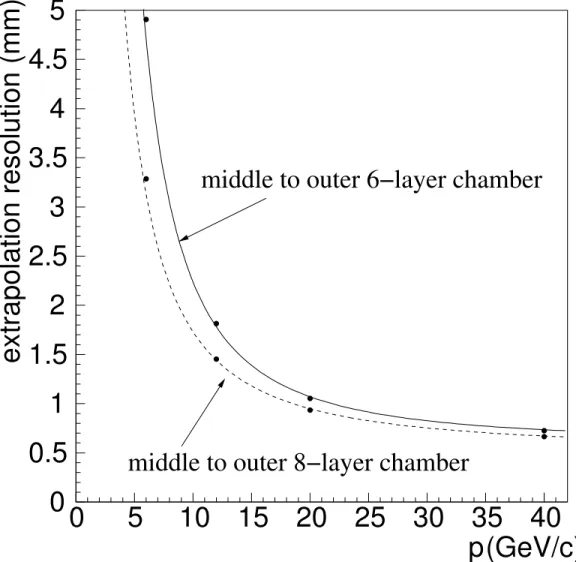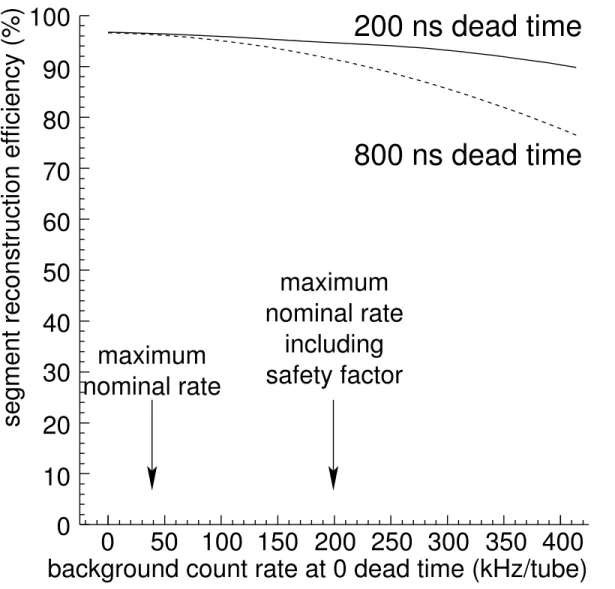Alignment of the ATLAS Muon Spectrometer with Tracks and Muon Identification at High
Background Rates
Oliver Kortner a , Hubert Kroha a , Jens Schmaler a , Chrysostomos Valderanis a
a Max-Planck-Institut f¨ ur Physik, F¨ ohringer Ring 6, D-80805 M¨ unchen, Germany
Abstract
In the ATLAS muon spectrometer, muons are reconstructed with 97% efficiency and a momentum resolution of better than 10% for p T < 1 TeV/c by three layers of precision drift-tube chambers in a toroidal magnetic field of 0.4 T. The high momentum resolution requires the alignment of the muon chambers with 30 µm accuracy which is guaranteed by a system of optical alignment sensors. We present a method which allows us to align the chambers with curved muon tracks with similar precision and, hence, to verify the optical alignment.
During the operation of the experiment, the muon chambers will be exposed to a high flux of neutrons and γ rays which may lead to occupancies of up to 16%.
We showed on test-beam data taken at the Gamma-Irradiation Facility at CERN that the anticipated reconstruction efficiency can be achieved with the precision chambers in this high-background environment and how it can be sustained at even higher background rates which are expected for a possible luminosity upgrade of the LHC.
1 Introduction
The ATLAS muon spectrometer consists of three layers of precision muon
chambers operated in a air-core toroid magnet system with an average field
strength of 0.4 T leading to an average bending power of 3 Tm. The precision
muon chambers are built out of two triple or quadruple layers of pressurized
drift tubes with a spatial resolution of 80 µm per tube. As the anode wires
of the tubes are positioned with 20 µm accuracy within a chamber, each
chamber provides a track-point measurement with an accuracy better than
40 µm. The relative positions of the chambers are measured by a system
optical alignment sensors, such that an overall momentum resolution better
than 10% up to 1 TeV/c is achieved. During the operation of the experiment, the muon chambers will be exposed to a high flux of neutrons and γ rays which leads to occupancies of up to 16%. The high detection efficiency of a single drift tube and the redundancy of the track point measurements by the different tube layers of a chambers ensure that the muon spectrometer has a muon detection efficiency > 97%.
In the first part of this note, we present a method to measure relative chamber positions with curved muon tracks with a similar precision as the optical alignment system. In the second part, we explore the limits of efficient muon reconstruction with the precision ATLAS muon chambers in the presence of a high γ background flux based on test-beam measurements preformed in the Gamma-Irradiation Facility at CERN.
2 Alignment of the ATLAS muon spectrometer with tracks
Muons traversing a so-called ”tower” of precision chambers leave a nearly straight segment in each of the chambers. These segments can be used to calculate a superpoint in each chambers which is the position of the muon trajectory in the middle of each chamber (see Fig. 1). As the muons fly on a curved path through the spectrometer due to the presence of the toroidal magnetic field, the superpoint of the middle chamber does not lie on the straight interconnection of the superpoints of the outer chambers. The sagitta s, i.e. the distance of the superpoint of the middle chamber from the straight interconnection of the superpoints of the outer chambers, is a measure for the muon momentum. s ≈ 500 µ m GeV p / c in the barrel part of the spectrometer where p denotes the muon’s momentum. The superpoints are measured with
≤ 40 µm accuracy leading to a sagitta resolution of ≤ 50 µm. Thus the muon’s momentum can be determined with ≤ 10% accuracy for p ≤ 1 TeV/c.
The sagitta is – by definition – very sensitive to a misalignment of the three chambers detecting a muon. It is therefore monitored continously with 30 µm by an optical alignment system. At the same time does the sagitta itself pro- vide no handle to check the optical alignment. An independent momentum measurement is needed.
This is not provided with sufficient accuracy by the track measurement in the
inner detector because of energy loss fluctuations in the calorimeters. But one
can make use of the fact that a muon chamber can measure the direction of
the muon trajectory in addition to the superpoint (cf. Fig. 1). One can de-
termine the momenta of low-energy muons with p T < 40 GeV/c in the muon
spectrometer with a resolution of a few percent by comparing the muon direc-
tions at the entrance and the exit of the muon spectrometer. The deflection
angle α out − α in is independent of the chamber’s misalignment and thus allows for monitoring relative chamber positions. Fig. 2 shows the resolution of the extrapolation of a single segment from the middle to the outer chambers as a function of the muon momentum which is determined by the deflection angle.
The resolution is about 5 mm for p T ≥ 6 GeV/c. Hence the misalignment of the chambers can be measured with 30 µm with about 30,000 muon tracks.
Unfortunately this accuracy is only achieved if the momentum measurement is unbiased on the level of 5 MeV/c or – equivalently – the deflection angle α out − α in is not biased by a relative rotation of the outer and inner cham- bers about the tube axes by more than 0.01 mrad. Yet another independent and, in particular, unbiased momentum measurement is needed. An unbiased momentum measurement of ≈ 20% statistical precision per 6 GeV muon can be obtained from the curvature of the muon trajectory in the middle chamber due to the high mechanical precision of the chamber. We conclude that 50,000 muons of 6 GeV/c momentum have to be collected to measure the relative rotation of the outer and inner chambers and the relative misalignment of all the chambers of a tower with the required accuracy. 50,000 muons per tower can be provided by a planned single muon data stream of 2,5 kHz rate within 3 hours of ATLAS operation at the LHC.
3 Muon reconstruction at high rates
As mentioned in the introduction, efficient reconstruction of muons must be guaranteed also in the presence of the high n-γ background in which the muon spectrometer will be operated. Monte-Carlo calculations [1] predict nominal counting rates of up to 40 kHz per tube in a six-layer and up to 60 kHz in an eight-layer chamber. The calculations have an uncertainty of a factor 5 in the predicted rates such that five times higher background counting rates may be encountered in ATLAS at full luminosity of the LHC.
Previous publications [2][3][4] show that, in a six-layer chamber, a segment re- construction efficiency ≥ 97% at the nominal background rates can be achieved with ≤ 0.1 fake segments per event. At a couting rate of 200 kHz per tube (five time the maximum nominal rate), the efficiency drops to 90% if the number of fake segments is kept below 0.25 per event. The efficiency can be almost recuperated by accepting 3.5 fake segments per event. This effect is caused by the fact that, at a rate of 200 kHz per tube, in 10% of the tracks only two out six muon hits are detected while the other four are masked by background hits. As any two hits can be interconnected by a straight line it is very difficult to distinguish the correct combination of two hits from the wrong ones.
This problem can be overcome if the dead time of the tube read-out is reduced
from its present value of 800 ns (equal to the maximum drift time of the tubes) to its minimum of 200 ns, as the reduction of the dead time reduces the probability of masking a muon hit by a background hit.
We studied the segment reconstruction efficiency as a function of the back- ground counting rate and the dead time of the drift-tube read-out with test- beam data which were recorded in a 100 GeV muon beam with an ATLAS 6-layer muon drift-tube chamber in the GIF at CERN in 2003 [3]. A silicon tracking detector was used as external reference in the test-beam set-up.
We followed the standard track-reconstruction strategy of ATLAS in our anal- ysis: We restricted the track search to the 3 cm wide region defined by the beam trigger and searched inside that region for at least 3 muon hits within a 500 µm straight road. If more than one segment is found, only those seg- ments are kept which have the maximum number of hits of the reconstructed segments.
The segment reconstruction efficiencies which were obtained in our analysis are presented in Fig. 3. The dashed curve shows the reconstruction efficiency obtained with the standard dead time of 800 ns. It agrees with the quoted result [4]. The solid line represents the efficiencies obtained with the reduced dead time of 200 ns. Efficiencies above 95% are reached even at the highest background rates including the safety factor of 5. An efficiency of 90% is achieved at ten times the maximum nominal rate. No increase in the number of fake segments is observed.
Counting rates ≥ 400kHz per tube can be encountered after the possible luminosity upgrade of the LHC. Our results indicate that a large fraction of the ATLAS muon chambers can be operated at an upgraded LHC.
4 Summary
We developed an algorithm based on muon tracks which allows us to monitor the relative positions of drift-tube chambers in a tower of the ATLAS muon spectrometer with an accuracy of 30 µm. The algorithms makes use of the di- rection capability of muon chambers which permits the determination of the muon momenta independently of the standard three-point sagitta measure- ment. The algorithm requires 50,000 muons of p T ≥ 6 GeV/c which will be recorded within 3 hours by the ATLAS experiment at the LHC. Our algorithm is complementary to the precision optical alignment monitoring system of the ATLAS muon spectrometer.
We proved with test-beam data taken at the Gamma Irradiation Facility at
CERN, that a high muon tracking efficiency ≥ 90% can be achieved even at background rates of up to 400 kHz per tube, if the read-out electronics of the tube is operated with a dead time which is small compared to the maximum drift time.
5 Figure captions
Fig. 1: The muon momentum can be determined either most precisely from a three point track-sagitta measurement or from the deflection angle α out − α in
of the muon trajectory in the muon spectrometer.
Fig. 2: Single-segment extrapolation accuracy as a function of the muon mo- mentum.
Fig. 3: Segment reconstruction efficiency for a six-layer ATLAS muon drift- tube chamber as a function of the background counting rates for two different dead-time settings of the read-out electronics as measured in the GIF.
References
[1] S. Baranov et al., Estimation of Radiation Background, Impact on Detectors, Activation and Shielding Optimization in ATLAS, ATLAS internal note ATL- COM-GEN-2005-001, Geneva 2005.
[2] J.F. Laporte et al., On the Number of Layers per Multilayer in MDT Chambers Part I, ATLAS internal note, Geneva, 1996.
[3] J. Dubbert et al., Operation of the ATLAS muon drift-tube chambers at high background rates and in magnetic fields, IEEE Transactions on Nuclear Science 53.
[4] D. Primor et al., A Novel Approach to Track Finding in a Drift Tube Chamber,
JINST 004P 1106.
Fig. 1


